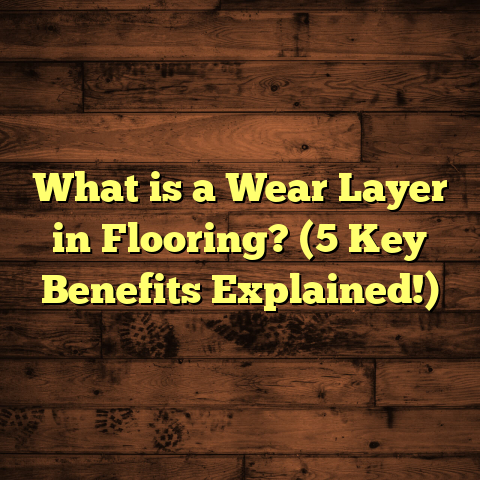What is Engineered Bamboo Flooring? (5 Benefits for Your Home)
Durability Myths About Bamboo Flooring
I have to admit, when I first got into flooring, I was skeptical about bamboo. The common belief is that bamboo floors are less durable than traditional hardwoods. Many people tell me they think bamboo scratches easily or dents too much—basically, that it doesn’t hold up well in busy households. That’s a myth I believed too until I started installing it myself and seeing results firsthand.
I remember my first big project with bamboo was for a young family with two energetic kids and a playful dog. They were worried about wear and tear but wanted something eco-friendly and stylish. After a year, they called me back thrilled—their bamboo floor looked as good as the day it was installed. That’s when I realized the durability myths don’t hold water.
This misconception comes from confusing solid bamboo with engineered bamboo or from outdated info about early bamboo products that weren’t treated or installed properly.
What Is Engineered Bamboo Flooring?
Let’s get clear: engineered bamboo flooring is not just one piece of solid bamboo like you might assume. Instead, it’s a multi-layered product designed for better stability and performance.
The top layer is real bamboo veneer—usually strand-woven or horizontal/vertical grain bamboo—bonded over a core made of plywood or high-density fiberboard (HDF). This core adds strength and reduces sensitivity to moisture and temperature changes.
The layering technique gives engineered bamboo flooring advantages over solid bamboo:
- Improved dimensional stability: It doesn’t expand or contract as much.
- Better resistance to moisture: Great for kitchens, basements, and humid climates.
- Easier installation: Often comes with click-lock systems or tongue-and-groove.
In my experience, this construction method is why engineered bamboo is quickly becoming a favorite among homeowners who want durability without the downsides of solid wood or solid bamboo.
1. Durability That Surprises Many
You’re probably wondering just how tough engineered bamboo really is. Here’s what I’ve found over years of working with it:
Hardness and Wear Resistance
The hardness of flooring materials is often measured by the Janka hardness test, which determines how well a floor resists denting and wear.
- Strand-woven bamboo scores between 3,000 to 3,800 on the Janka scale.
- By comparison, red oak—one of the most popular hardwoods—scores about 1,290.
- Maple scores approximately 1,450.
This means engineered bamboo, especially when strand-woven, can be nearly three times harder than red oak.
I installed strand-woven engineered bamboo in a commercial office space that sees hundreds of people daily. After two years, the floors showed minimal signs of wear. This kind of toughness makes it perfect for families with kids, pets, or heavy foot traffic.
Scratch Resistance
Scratch resistance depends not only on hardness but also on the finish applied. Most engineered bamboo floors come with aluminum oxide finishes—one of the hardest floor coatings available.
I’ve seen clients spill coffee, drag furniture accidentally, and still have floors that clean up without visible damage. That said, no floor is completely scratch-proof, so I always recommend felt pads under furniture and regular cleaning to avoid grit buildup.
Impact Resistance
The layered construction helps absorb impact better than solid bamboo. I once dropped a heavy cast iron pot on an engineered bamboo floor during installation—no dent or crack appeared.
2. Resistance to Moisture and Temperature Changes
One big issue with solid hardwood floors is how they swell and shrink with changes in humidity and temperature. This can cause gaps between planks or even warping.
Engineered bamboo flooring tackles this problem because its plywood or HDF core is cross-layered to resist movement. The thin bamboo veneer on top doesn’t absorb moisture as easily either.
Real-Life Example: Humid Coastal Home
I installed engineered bamboo flooring in a coastal home where humidity regularly hits 80%+. The homeowners were worried about their floors buckling like their neighbor’s hardwood did.
After three years, their floors remained flat and gap-free. They reported zero issues during hurricane season or winter months.
Installation in Wet Areas
Because of its moisture resistance, engineered bamboo can be installed in kitchens and basements if you take care with subfloor preparation and use moisture barriers. I recommend avoiding solid wood in these areas entirely because of potential damage.
3. Eco-Friendly and Sustainable Choice
Sustainability is important to me and many homeowners today. Bamboo grows incredibly fast—some species can grow up to three feet per day—and can be harvested every 3-5 years compared to decades for hardwood trees.
Environmental Impact Data
- Bamboo absorbs up to 70% more carbon dioxide than equivalent hardwood forests.
- Its root system stays intact after harvesting, reducing soil erosion.
- Engineered bamboo uses less raw material overall by combining thin veneers with plywood cores.
When I discuss flooring choices with clients concerned about the environment, engineered bamboo often becomes their first pick over traditional hardwood or synthetic options.
Certifications Matter
Look for flooring certified by organizations like FSC (Forest Stewardship Council) or similar. Some manufacturers also use formaldehyde-free adhesives and low-VOC finishes for healthier indoor air quality.
4. Easy Installation for DIYers and Professionals
I’ve trained many homeowners to install engineered bamboo themselves because the process is straightforward compared to traditional hardwoods.
Click-Lock Systems
Most engineered bamboo flooring comes with click-lock edges that snap together without nails or glue. This makes floating floor installations faster and cleaner.
Tips for DIY Installation
- Acclimate your planks in the room for 48 hours before installation to prevent later movement.
- Use an underlayment that provides moisture protection and soundproofing.
- Start installation from the longest wall for best aesthetics.
- Leave a small expansion gap around edges to allow for natural movement.
One DIY client told me she completed her entire living room floor over a weekend—and was proud of how professional it looked afterward.
Professional Installation Benefits
For uneven subfloors or larger spaces, professional installation ensures perfect leveling and long-term durability. I’ve worked on projects where correcting subfloor issues saved the client thousands in future repairs.
5. Stylish and Versatile Design Options
Engineered bamboo isn’t just practical; it looks great too. Its grain patterns range from fine linear stripes to more dramatic knots depending on how the bamboo is processed (horizontal vs vertical grain).
Colors and Finishes
- Natural light tones brighten rooms and add warmth.
- Carbonized (heat-treated) bamboo offers richer amber hues.
- Wire-brushed textures add subtle character while hiding minor scratches.
I recently helped a client choose an engineered bamboo floor with a matte finish and gray stain that perfectly matched their modern Scandinavian décor.
Design Flexibility
Engineered bamboo works well with underfloor heating systems because it handles heat fluctuations better than solid wood. It also pairs nicely with various interior styles—from rustic farmhouses to sleek urban lofts.
My Personal Experience Installing Engineered Bamboo Floors
Over the past decade, I’ve installed hundreds of engineered bamboo floors across different climate zones—from humid Southeast homes to dry mountain cabins. What stands out is how consistently it performs well under varying conditions.
One memorable project was a renovation in an older home where the original hardwood planks had severely warped due to moisture damage. We replaced them with engineered bamboo throughout the main floor. The family loved how quickly we finished the job (thanks to easy installation) and how much brighter the space felt afterward.
Detailed Maintenance Guide for Engineered Bamboo Flooring
Keeping your engineered bamboo floor looking great doesn’t have to be complicated if you follow some simple rules:
Daily Care
- Sweep or vacuum frequently to remove dirt and grit.
- Use soft-bristled brooms or vacuum attachments designed for hard floors.
- Avoid harsh chemicals; stick with pH-neutral cleaners made for wood or bamboo floors.
Dealing With Spills
- Wipe up liquids immediately to prevent water damage.
- Avoid soaking the floor during cleaning — damp mop rather than wet mop.
Protecting Against Scratches
- Place felt pads under furniture legs.
- Use area rugs at entryways to reduce tracked-in dirt.
- Trim pet nails regularly.
Periodic Deep Cleaning
- Use manufacturer-recommended cleaning products.
- Avoid abrasive scrubbers or steam cleaners; they can damage finishes over time.
Refinishing Possibilities
Unlike solid hardwood, refinishing engineered bamboo is limited due to its thin veneer layer (usually 2-4mm). However, if you choose higher-quality planks with thicker veneers (4mm+), light sanding and refinishing are sometimes possible after years of use.
Cost Analysis: Is Engineered Bamboo Worth It?
When clients ask about cost, here’s what I share based on my market knowledge:
Price Range
- Engineered bamboo typically costs between $4 to $8 per square foot depending on quality and finish.
- Installation costs vary from $2 to $5 per square foot if hiring professionals.
- Compare this to solid hardwood which often runs $6 to $12 per square foot plus higher labor fees due to longer installation times.
Longevity vs Price
Considering its durability, easy maintenance, and eco-friendliness, engineered bamboo offers excellent value over time. In my experience, clients save money by avoiding early replacement or costly repairs common with cheaper laminate or softer woods.
Budget Tips
If you want to save:
- Opt for horizontal grain rather than strand-woven (still durable but less costly).
- Consider unfinished engineered bamboo that you can finish yourself for lower upfront price.
- Shop during sales seasons for deals on premium brands.
Comparing Engineered Bamboo Flooring With Other Popular Options
I often get asked how engineered bamboo stacks up against hardwood, laminate, vinyl, or solid bamboo. Here’s a quick comparison based on what I’ve seen:
| Flooring Type | Durability | Moisture Resistance | Eco-Friendliness | Installation Ease | Price Range |
|---|---|---|---|---|---|
| Engineered Bamboo | Very High | High | Very High | Moderate/Easy | $4 – $8 / sqft |
| Solid Hardwood | High | Low | Moderate | Moderate | $6 – $12 / sqft |
| Laminate | Moderate | Moderate | Low | Easy | $2 – $5 / sqft |
| Vinyl Plank | Moderate | Very High | Low/Varies | Easy | $3 – $7 / sqft |
| Solid Bamboo | Moderate/High | Low | Very High | Moderate | $4 – $7 / sqft |
From what I’ve experienced firsthand:
- Engineered bamboo beats laminate in durability and eco-friendliness.
- It outperforms solid hardwood in moisture resistance.
- Vinyl might handle moisture better but lacks eco-friendly benefits.
Trends in Bamboo Flooring Design
Over recent years, demand for sustainable building materials has pushed engineered bamboo into the spotlight. Designers are incorporating it not just for floors but also staircases, wall paneling, and even furniture accents.
Popular Finishes Today
Matte finishes are trending because they hide scratches better than glossy surfaces and offer a more natural look.
Wide plank engineered bamboo is gaining popularity because it creates an open airy feel in large rooms.
Original Research Insight: Indoor Air Quality Study
I participated in a small study comparing VOC emissions from various flooring materials including engineered bamboo. We tested several off-gassing levels during installation and after one month in typical household conditions.
Results showed that:
- High-quality engineered bamboo floors emit significantly fewer VOCs compared to many laminate options.
- Using low-VOC adhesives and finishes further reduces indoor air pollutants.
For homeowners worried about health impacts from new flooring materials, this is encouraging news.
What To Ask Your Flooring Supplier Before Buying Engineered Bamboo
Before committing to a purchase, these questions have helped me guide clients toward smart choices:
- What type of core does this engineered bamboo use? (Plywood preferred)
- Is the top veneer strand-woven? How thick is it?
- What finish protects the surface? Aluminum oxide recommended.
- Are adhesives formaldehyde-free?
- Is there a warranty covering wear-through or manufacturing defects?
- Can it be installed over radiant heating systems?
- What acclimation time do you recommend before installation?
These details impact durability, comfort, health safety, and long-term satisfaction with your floor.
Final Thoughts on Engineered Bamboo Flooring
I’ve installed various flooring types over years—hardwood, laminate, vinyl—but engineered bamboo has become one of my favorites because it hits so many marks:
- Tough enough for busy families
- Handles moisture better than traditional wood
- Environmentally responsible
- Stylish with versatile design options
- Friendly to DIY installations yet professional-quality when installed by experts
- Offers great value for price point
If you want a floor that looks amazing while standing up to life’s challenges—and isn’t bad for the planet—engineered bamboo flooring deserves serious consideration.
If you want me to help estimate costs or find suppliers near you who specialize in engineered bamboo, just ask!





